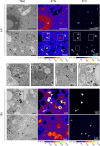Heterotrophic Foraminifera Capable of Inorganic Nitrogen Assimilation
- PMID: 33343548
- PMCID: PMC7744380
- DOI: 10.3389/fmicb.2020.604979
Heterotrophic Foraminifera Capable of Inorganic Nitrogen Assimilation
Abstract
Nitrogen availability often limits biological productivity in marine systems, where inorganic nitrogen, such as ammonium is assimilated into the food web by bacteria and photoautotrophic eukaryotes. Recently, ammonium assimilation was observed in kleptoplast-containing protists of the phylum foraminifera, possibly via the glutamine synthetase/glutamate synthase (GS/GOGAT) assimilation pathway imported with the kleptoplasts. However, it is not known if the ubiquitous and diverse heterotrophic protists have an innate ability for ammonium assimilation. Using stable isotope incubations (15N-ammonium and 13C-bicarbonate) and combining transmission electron microscopy (TEM) with quantitative nanoscale secondary ion mass spectrometry (NanoSIMS) imaging, we investigated the uptake and assimilation of dissolved inorganic ammonium by two heterotrophic foraminifera; a non-kleptoplastic benthic species, Ammonia sp., and a planktonic species, Globigerina bulloides. These species are heterotrophic and not capable of photosynthesis. Accordingly, they did not assimilate 13C-bicarbonate. However, both species assimilated dissolved 15N-ammonium and incorporated it into organelles of direct importance for ontogenetic growth and development of the cell. These observations demonstrate that at least some heterotrophic protists have an innate cellular mechanism for inorganic ammonium assimilation, highlighting a newly discovered pathway for dissolved inorganic nitrogen (DIN) assimilation within the marine microbial loop.
Keywords: ammonium assimilation; foraminifera; heterotrophic protists; heterotrophy; marine; nitrogen cycle.
Copyright © 2020 Bird, LeKieffre, Jauffrais, Meibom, Geslin, Filipsson, Maire, Russell and Fehrenbacher.
Conflict of interest statement
The authors declare that the research was conducted in the absence of any commercial or financial relationships that could be construed as a potential conflict of interest.
Figures




References
-
- Azam F., Fenchel T., Field J. G., Grey J. S., Meyer-Reil L. A., Thingstad F. (1983). The ecological role of water-column microbes. Mar. Ecol. Prog. Ser. 10 257–263. 10.3354/meps010257 - DOI
-
- Bird C., Darling K. F., Russell A. D., Davis C. V., Fehrenbacher J., Free A., et al. (2017). Cyanobacterial endobionts within a major marine planktonic calcifier (Globigerina bulloides, Foraminifera) revealed by 16S rRNA metabarcoding. Biogeosciences 14 901–920. 10.5194/bg-14-901-2017 - DOI
-
- Bird C., Darling K. F., Russell A. D., Fehrenbacher J. S., Davis C. V., Free A., et al. (2018). 16S rRNA gene metabarcoding and TEM reveals different ecological strategies within the genus Neogloboquadrina (planktonic foraminifer). PLoS One 13:e0191653. 10.1371/journal.pone.0191653 - DOI - PMC - PubMed
LinkOut - more resources
Full Text Sources

